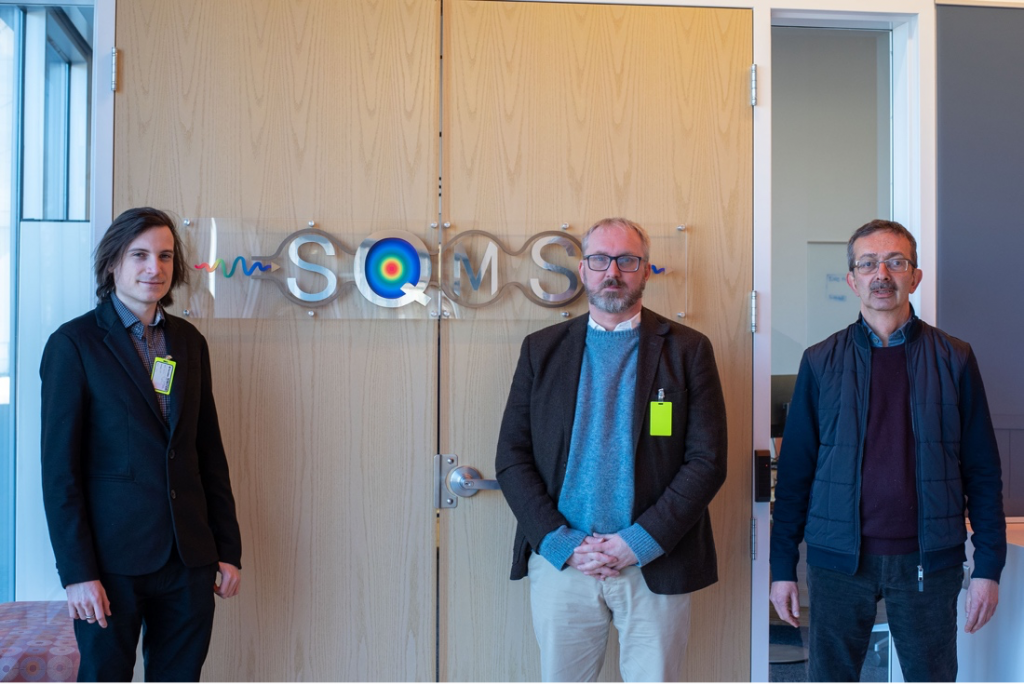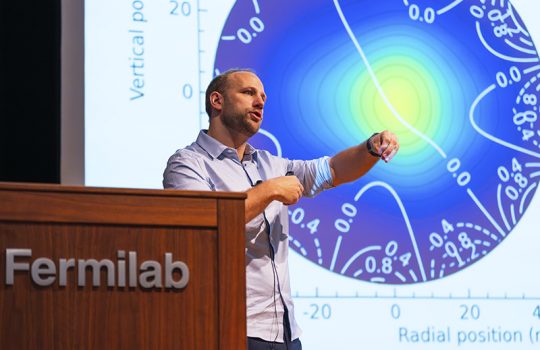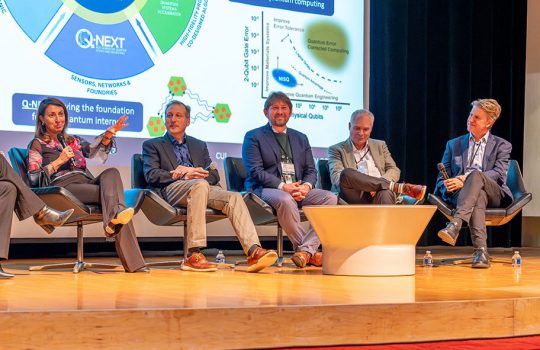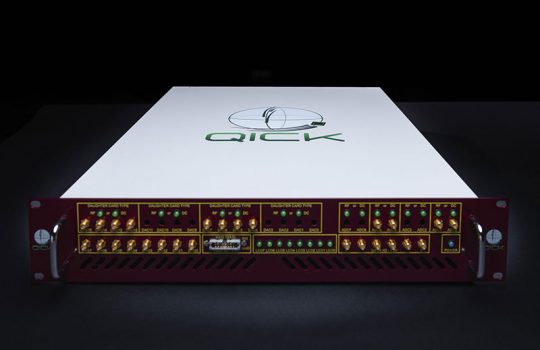The United States and United Kingdom are sharing expertise and capabilities in the blossoming field of quantum information science across the pond. This new partnership between the countries will lead to new quantum devices, insights into their performance, ways to harness quantum information and discoveries in fundamental physics.
Research will be conducted under the Superconducting Quantum Materials and Systems Center, hosted by the U.S. Department of Energy’s Fermi National Accelerator Laboratory, with the United Kingdom’s National Physical Laboratory and Royal Holloway, University of London. With the additional institutions, the SQMS Center collaboration now totals 28 partners.

From left to right: Marius Hegedus, Tobias Lindstrom and Alexander Tzalenchuk stand outside the door to Quantum Computing Lab-3 during their visit to SQMS Center’s headquarters on Fermilab’s campus. Photo: SQMS Center
These new additions to the SQMS Center are rooted in goals to increase cooperation in the field of quantum information science between the U.S. and U.K. governments. These goals were set in a November 2021 joint statement that emphasizes the importance of growing an ecosystem of international partners with shared values. The statement also highlights the impact of quantum technology on global health security, climate change and efficient resource use.
“Our new U.K. partners bring unique characterization techniques that complement the SQMS Center’s strengths,” said Anna Grassellino, director of the SQMS Center. “This partnership advances the center’s mission of identifying and overcoming fundamental obstacles that interfere with quantum device performance, while also finding ways to use quantum devices to harness quantum information and perform physics and sensing experiments.”
New investigations
Quantum information science seeks to harness the behavior of quantum mechanics to process information in new ways, develop ultra-sensitive detectors and much more.
Under these new partnerships, researchers will investigate the following: losses of quantum information in quantum computing devices, new systems based on quantum technologies to search for new particles, new quantum algorithms, and the performance and fundamental limits of quantum computers.
“The areas the SQMS Center focuses on are building high-quality superconducting qubits and looking at ways in which this will scale for both quantum computing and fundamental physics,” said Sir Peter Knight, chair of the U.K. National Quantum Technologies Programme and SQMS Center advisory board member.
Scientists will use quantum computers to manipulate qubits — the basic building block of information used by quantum computers — to perform calculations that would be practically impossible for classical computers when the machines are fully realized.
“Superconducting qubits can be used as a quantum computing engine, but equally in the other direction for dark matter detection,” said Knight. “Quantum has become a major part of the scientific adventure that everybody wants to participate in, and SQMS is going to be a beacon of getting stuff done. NPL and RHUL researchers are excited to become collaborative SQMS Center partners.”
Cutting-edge capabilities
Quantum devices need to be cooled down to prevent information from being obscured or lost by noise produced by heat. Making devices ultra-cold might lead to better device performance and new insights on how quantum devices behave and operate.
RHUL performs cutting-edge research in quantum and hosts the London Low Temperature Laboratory. Researchers at RHUL have experience cooling quantum devices down to the microkelvin range, or millionths of degrees kelvin. This temperature regime is much colder than where researchers typically operate devices, which are the millikelvin range or thousandth degrees kelvin.
“What my group brings to the table is expertise in low-temperature physics into the microkelvin regime,” said John Saunders, a professor at RHUL and SQMS Center advisory board member. “For approximately the last 10 years, we’ve been working on developing new low-temperature platforms and working on cooling down quantum circuits and quantum materials to the lowest possible temperatures. We are very interested in cooling them down to ultra-low temperatures to see how they behave,” said Saunders.
This expertise in low temperatures complements the National Physical Laboratory’s capabilities. The National Physical Laboratory serves a similar function as the United States’ National Institute of Standards and Technology, both of which perform precision measurements to maintain measurement standards for their respective countries. NIST is also a core partner within the SQMS Center.
“Quantum has become a major part of the scientific adventure that everybody wants to participate in, and SQMS is going to be a beacon of getting stuff done.” – Sir Peter Knight, chair of the U.K. National Quantum Technologies Programme
“As the NPL head of science for quantum technologies, I lead a team of about 100 scientists working on various aspects of computing, sensing, communications, metrology, and materials,” said Alexander Tzalenchuk, the SQMS Center principal investigator for NPL. “In particular, we strive to understand and mitigate noise in superconducting circuits, which affects their ‘quantumness.’ We also work on algorithms and developing technologies that enable scalable quantum computing in the future. This formal collaboration is one of the first examples where the two countries can work together on closely aligned projects, which is enabled by the joint statement.”
“We want to make quantum technologies viable in order to provide new tools and capabilities that benefit our national initiative as well as, more broadly, the world,” said Abid Patwa, program manager for SQMS in DOE’s Office of High Energy Physics. “We need to learn more about the fundamental aspects of QIS, such as cryogenics, and to understand the underlying mechanisms that currently limit quantum computing devices.
“The United Kingdom continues to be an excellent partner to the United States and has the expertise as well as the essential resources to test and build on the QIS fundamentals,” said Patwa. “These efforts will further advance our insights in quantum research to enable this emerging technology.”
The Superconducting Quantum Materials and Systems Center at Fermilab is supported by the DOE Office of Science.
The Superconducting Quantum Materials and Systems Center is one of the five U.S. Department of Energy National Quantum Information Science Research Centers. Led by Fermi National Accelerator Laboratory, SQMS is a collaboration of 28 partner institutions—national labs, academia and industry—working together to bring transformational advances in the field of quantum information science. The center leverages Fermilab’s expertise in building complex particle accelerators to engineer multiqubit quantum processor platforms based on state-of-the-art qubits and superconducting technologies. Working hand in hand with embedded industry partners, SQMS will build a quantum computer and new quantum sensors at Fermilab, which will open unprecedented computational opportunities. For more information, please visit sqmscenter.fnal.gov.
Fermi National Accelerator Laboratory is supported by the Office of Science of the U.S. Department of Energy. The Office of Science is the single largest supporter of basic research in the physical sciences in the United States and is working to address some of the most pressing challenges of our time. For more information, please visit science.energy.gov.



